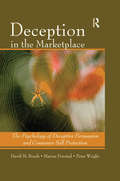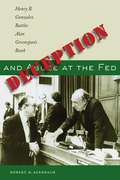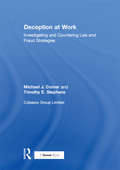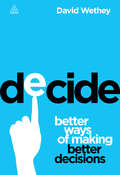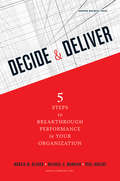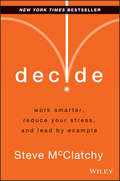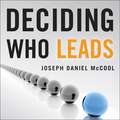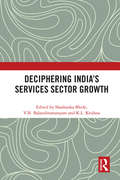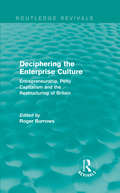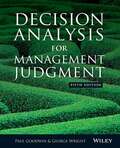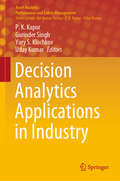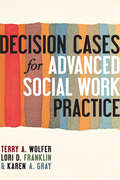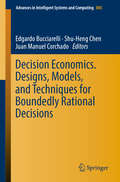- Table View
- List View
Deception In The Marketplace: The Psychology of Deceptive Persuasion and Consumer Self-Protection
by Peter Wright David M. Boush Marian FriestadThis is the first scholarly book to fully address the topics of the psychology of deceptive persuasion in the marketplace and consumer self-protection. Deception permeates the American marketplace. Deceptive marketing harms consumers’ health, welfare and financial resources, reduces people’s privacy and self-esteem, and ultimately undermines trust in society. Individual consumers must try to protect themselves from marketers’ misleading communications by acquiring personal marketplace deception-protection skills that go beyond reliance on legal or regulatory protections. Understanding the psychology of deceptive persuasion and consumer self-protection should be a central goal for future consumer behavior research. The authors explore these questions. What makes persuasive communications misleading and deceptive? How do marketing managers decide to prevent or practice deception in planning their campaigns? What skills must consumers acquire to effectively cope with marketers’ deception tactics? What does research tell us about how people detect, neutralize and resist misleading persuasion attempts? What does research suggest about how to teach marketplace deception protection skills to adolescents and adults? Chapters cover theoretical perspectives on deceptive persuasion; different types of deception tactics; how deception-minded marketers think; prior research on how people cope with deceptiveness; the nature of marketplace deception protection skills; how people develop deception protection skills in adolescence and adulthood; prior research on teaching consumers marketplace deception protection skills; and societal issues such as regulatory frontiers, societal trust, and consumer education practices. This unique book is intended for scholars and researchers. It should be essential reading for upper level and graduate courses in consumer behavior, social psychology, communication, and marketing. Marketing practitioners and marketplace regulators will find it stimulating and authoritative, as will social scientists and educators who are concerned with consumer welfare.
Deception and Abuse at the Fed
by Robert D. Auerbach Henry B. Gonzalez Battles Alan Greenspan'S BankThe Federal Reserve-the central bank of the United States-is the most powerful peacetime bureaucracy in the federal government. Under the chairmanship of Alan Greenspan (1987-2006), the Fed achieved near mythical status for its part in managing the economy, and Greenspan was lauded as a genius. Few seemed to notice or care that Fed officials operated secretly with almost no public accountability. There was a courageous exception to this lack of oversight, however: Henry B. Gonzalez (D-TX)-chairman of the U. S. House of Representatives Financial Services (banking) Committee. In Deception and Abuse at the Fed, Robert Auerbach, a former banking committee investigator, recounts major instances of Fed mismanagement and abuse of power that were exposed by Rep. Gonzalez, including:- Blocking Congress and the public from holding powerful Fed officials accountable by falsely declaring-for 17 years-it had no transcripts of its meetings;- Manipulating the stock and bond markets in 1994 under cover of a preemptive strike against inflation;- Allowing $5. 5 billion to be sent to Saddam Hussein from a small Atlanta branch of a foreign bank-the result of faulty bank examination practices by the Fed;- Stonewalling Congressional investigations and misleading the Washington Post about the $6,300 found on the Watergate burglars. Auerbach provides documentation of these and other abuses at the Fed, which confirms Rep. Gonzalez's belief that no government agency should be allowed to operate with the secrecy and independence in which the Federal Reserve has shrouded itself. Auerbach concludes with recommendations for specific, broad-ranging reforms that will make the Fed accountable to the government and the people of the United States.
Deception at Work: Investigating and Countering Lies and Fraud Strategies
by Michael J. Comer Timothy E. StephensDeception at Work tells you how to recognize and deal with lies, in meetings, negotiations, discussions and in writing. It is guaranteed to make you a more effective and confident operator, no matter what job you do. Simply leaving the book on your desk for others to see will improve your chances of not being deceived. The book exposes deception in all of its forms, linking the authors' 40 years of experience in dealing with fraudsters with the most recent findings on MRI scanning and the human brain. It explains how, why and in what circumstances both achievement and exculpatory lies are told, and how they can be resolved. It sets out a low key but effective plan for dealing with liars in all shapes and sizes, from confidence tricksters to malingerers and hard-nosed fraudsters. This ground-breaking work includes the most comprehensive summary of the clues to deception of any book currently in print.
Deception in Business: A Legal Perspective
by Christopher M. Bruner Lynn Sharp PaineDiscusses several of the most important prohibitions on deception found in U.S. law, starting with the basic elements of liability for fraud and moving to important antifraud provisions in federal statutes, restrictions on "misrepresentation" in consumer and contract law, deceptive nondisclosure, and forms of sales "puffery" that are not legally actionable.
Deception in Business: A Legal Perspective
by Christopher M. Bruner Lynn Sharp PaineDiscusses several of the most important prohibitions on deception found in U.S. law, starting with the basic elements of liability for fraud and moving to important antifraud provisions in federal statutes, restrictions on "misrepresentation" in consumer and contract law, deceptive nondisclosure, and forms of sales "puffery" that are not legally actionable.
Deception in Selection: Interviewees and the Psychology of Deceit
by Max A. EggertThe latest research suggests that 33% of people lie deliberately to achieve employment. The costs of mis-hires are significant in terms of management time, selection and reselection costs and potential legal costs. There are 101 opportunities for applicants to economize with the truth, exaggerate or simply lie, both on their CV and at interview. They may be desperate in a competitive job market; they may think that exaggeration is an expected part of the process or they just rely on the fact that many employers still fail to make the most rudimentary of checks of what they are told. Max Eggert’s Deception in Selection will help you, the recruiter, to understand how and why candidates deceive. The book examines proven techniques and tactics to balance the interview game, to restore equity in the face of the clever approaches that sophisticated candidates bring to the interview. Although there is no foolproof way of identifying deception, you can, with practice, become amazingly accurate if there is a commitment to master the basics. The object of this book is to learn how to detect more effectively the fabrications that candidates present in selection situations that would have a direct adverse effect on their performance in the job. Reading it will encourage you to look at lying and truth telling in a new light and discover how pervasively lies and self-deception influence selection decisions. This is a must read guide from a best-selling business author for all those who participate in the selection process.
Decide
by David WetheyLife presents us with a steady stream of decisions that we have to make. So, like it or not, we need to practice this skill every day - at work, at home, and in every aspect of our lives. Yet, we often make decisions without properly considering the context, options and implications of our actions. Or worse still, we end up managing the consequences of avoiding taking difficult decisions. Decide sets out a clear and easy to follow model that will enable you to make or contribute to effective decisions, proving that it does not have to be a long drawn out process, as long as you use a mixture of rational and lateral thinking. Free from business jargon, and filled with relevant case studies, Decide is a vital book for everyone whose life revolves around successful decision making. Thought-provoking and practical, it will help you always make the right decisions, and choose from your options wisely, whether you have 60 days, 60 minutes or just 60 seconds.
Decide and Conquer: 44 Decisions that will Make or Break All Leaders
by David SiegelSuccess boils down to one thing: making good decisions. Learn the right framework now that can make all the difference later when faced with terrible options, deep anxiety and fear of failure.Access the decision framework David Siegel used when he took over as CEO of Meetup, the world&’s leading platform for making connections and finding your community. Let David&’s success during one of the most tumultuous times in his company&’s history help guide you on your own path. Decide and Conquer helps all leaders navigate the big decisions that will impact their future and make their organizations a success. David outlines the 44 challenges leaders face when starting a new position, then shows you the decision framework he applied to overcome challenges in his own role. David takes you on an epic journey of corporate and personal survival that includes industry titans like Adam Neumann, Barry Diller, Jack Welch, Bill Ackman, and other leaders.In Decide and Conquer, you will learn to:Apply principles like open communication, transparency, and kindness to inform great decision making.Set yourself up to succeed, even before you start, by removing potential roadblocks before they become a problem.Be a bold and decisive leader and not succumb to fear. By applying the principles he had learned in previous leadership positions, David was able to make the many critical decisions that would mean life or death for Meetup when WeWork decided to sell the company.From deciding to accept the position and negotiating terms to managing a seemingly endless series of crises during the sale and global pandemic, Decide and Conquer walks readers through the key decisions they will face with invaluable advice for each one.
Decide and Deliver
by Paul Rogers Michael C. Mankins Marcia BlenkoDithering. Decisions that turn out wrong. Decisions that people sabotage or don't know how to implement. If your company's experiencing these problems, it's not alone. Most organizations don't know how to make and execute good decisions. And they're paying a high price--as profitability and competitiveness erode.It doesn't have to be this way. In Decide and Deliver, the authors draw on Bain & Company's extensive research to present a five-step process for improving your firm's decision effectiveness:1. Assess your decision effectiveness--and how your organization affects it.2. Identify your critical decisions.3. Set individual critical decisions up for success.4. Ensure that your company enables and reinforces great decision making and execution.5. Embed the changes in everyday practice.Master this process, and you see immediate results: people across your organization collaborate to make crucial decisions better and faster than your rivals. And they execute them flawlessly-fueling unprecedented financial performance.Filled with powerful hands-on tools and detailed examples from companies as varied as Ford Motor Company, British American Tobacco, Telstra, Lafarge, and ABB UK, Decide and Deliver helps you make decision management a potent competitive weapon in your company.
Decide: Work Smarter, Reduce Your Stress, and Lead by Example
by Steve McClatchyHow to make better decisions and achieve your goals What shapes a person's career and life, and defines them as a leader? Their decisions. We all want to be more productive and deliver our best results. But doing this effectively—and consistently over time—is a significant challenge. Managing it all is hard, and leading in today's hyper-paced world is even harder. The good news is that leadership expert Steve McClatchy makes it easier. In Decide, McClatchy—who works with Fortune 1000 people every day to help them achieve outstanding levels of performance—shows you how to cut through the complexities and excuses to start realizing real gains simply by changing one thing: the way you make decisions. With McClatchy's help, you can quickly begin to: Use the time you have each day to move your business and your life forward Make decisions that yield better results Waste less time, reduce stress and regain balance Again and again, McClatchy has helped people learn for themselves how great decision-making habits yield a lifetime of accomplishments. Follow McClatchy's no-nonsense and practical approach, and you'll soon manage—and even lead—at your highest level of personal performance.
Deciding Who Leads: How Executive Recruiters Drive, Direct, and Disrupt the Global Search for Leadership Talent
by Joseph Daniel McCoolDeciding Who Leads offers a front-row seat from which to witness the high-stakes drama, victories, and missteps that characterize the executive search process amid what has become an intense, truly global competition for leadership talent.Enter the secret world of executive search consulting . . . and discover how this influential-but largely invisible-profession is charting the course of global business. Executive search expert Joseph Daniel McCool delivers a rich exposé of the elite world of search consulting-the single most influential form of management consulting engaged by organizations - and its powerful impact on the future of organizational performance, culture, and profits. Deciding Who Leads offers a front-row seat from which to witness the high-stakes drama, victories, and missteps that characterize the executive search process amid what has become an intense, truly global competition for leadership talent.(P)2017 John Murray Press
Deciphering India's Services Sector Growth
by Shashanka Bhide; V.N. Balasubramanyam; K.L. KrishnaThis book addresses a range of issues relating to the nature and implications of growth of India’s services sector, including factors contributing to the rise of services, output measurement and heterogeneity, growth of services exports, and employment in services sectors. From service tax, exchange rate and services exports, policy interest, employment potential and diversity of the sector to challenges in financial inclusion, trajectories of ICT services and contribution of education to GDP, it brings together diverse themes to highlight major concerns in the wake of the prominent role that services have played in placing India among the fast-growing economies in the world in recent years. The services sector in India accounts for more than 60 per cent of the GDP of the country and 28.6 per cent of its employed across government, private or state corporations and non-government organisations. The volume explores whether the services sector (beyond agriculture and industry) holds the promise of fulfilling the benefits from India’s demographic dividend for its economic transformation through sustainable growth. With key empirical analyses of household, enterprise and macroeconomic data for India within both formal and informal sectors, this topical book will be useful to scholars and researchers of economics, Indian economy, political economy, development economics, development studies, public policy and South Asian studies and also to development professionals, policy makers and industry specialists.
Deciphering the Enterprise Culture: Entrepreneurship, Petty Capitalism and the Restructuring of Britain (Routledge Revivals)
by Roger BurrowsThe idea of the ‘enterprise culture’ has been much vaunted over the last few decades: the growth of self-employment and small business ownership has been an important feature of the restructuring of the British economy. Because it is a concept that is difficult to evaluate, controversial and politically sensitive, social scientists were slow to analyse it. Consequently, it had been caricatured and many questions about its impact on society and the economy had been left unanswered. This collection, which was first published in 1991, presents a critical analysis of the various manifestations of the enterprise culture. Drawing upon a range of research, it deals with a number of related topics. The result is a powerful analysis of the material and ideological role of the petty bourgeoisie in contemporary capitalism. Its multidisciplinary approach, which contributions from leading scholars in the field, makes this book of interest to anyone wanting to make sense of the socio-economic restructuring of Britain.
Decision Analysis
by George WuDescribes decision analysis, a systemic approach for analyzing decision problems. A running example illustrates problem structuring (decision trees), probability assessment and endpoint evaluation, folding back the tree as a method of analysis, and sensitivity analysis.
Decision Analysis
by George Wu Kathleen L. McginnDescribes decision analysis, a systemic approach for analyzing decision problems. A running example illustrates problem structuring (decision trees), probability assessment and endpoint evaluation, folding back the tree as a method of analysis, and sensitivity analysis.
Decision Analysis Applied to the Field of Environmental Health (Professional Practice in Earth Sciences)
by Dilber Uzun Ozsahin Berna Uzun James LaMoreaux Tamer SanlidagThis book provides students and researchers with a resource that includes the current application of the multi-criteria decision theory in a variety of fields, including the environment, health care, engineering, and architecture. There are many critical parameters (criteria) that can directly or indirectly affect the consequences of various decisions. The application of the multi-criteria decision theory focusses mainly on the use of computational methods which include multiple criteria and orders of preference for the evaluation and the selection of the best option among many alternatives based on the desired outcome. The theory of multi-criteria decision making (MCDM) is an approach that can be extremely useful for students, managers, engineers of manufacturing companies, etc.
Decision Analysis for Management Judgment
by George Wright Paul GoodwinDecision Analysis for Management Judgment is unique in its breadth of coverage of decision analysis methods. It covers both the psychological problems that are associated with unaided managerial decision making and the decision analysis methods designed to overcome them. It is presented and explained in a clear, straightforward manner without using mathematical notation. This latest edition has been fully revised and updated and includes a number of changes to reflect the latest developments in the field.
Decision Analysis for Management Judgment
by Paul Goodwin and George WrightDecision Analysis for Management Judgment is unique in its breadth of coverage of decision analysis methods. It covers both the psychological problems that are associated with unaided managerial decision making and the decision analysis methods designed to overcome them. It is presented and explained in a clear, straightforward manner without using mathematical notation. This latest edition has been fully revised and updated and includes a number of changes to reflect the latest developments in the field.
Decision Analytics Applications in Industry (Asset Analytics)
by Uday Kumar P. K. Kapur Gurinder Singh Yury S. KlochkovThis book presents a range of qualitative and quantitative analyses in areas such as cybersecurity, sustainability, multivariate analysis, customer satisfaction, parametric programming, software reliability growth modeling, and blockchain technology, to name but a few. It also highlights integrated methods and practices in the areas of machine learning and genetic algorithms. After discussing applications in supply chains and logistics, cloud computing, six sigma, production management, big data analysis, satellite imaging, game theory, biometric systems, quality, and system performance, the book examines the latest developments and breakthroughs in the field of science and technology, and provides novel problem-solving methods. The themes discussed in the book link contributions by researchers and practitioners from different branches of engineering and management, and hailing from around the globe. These contributions provide scholars with a platform to derive maximum utility in the area of analytics by subscribing to the idea of managing business through system sciences, operations, and management. Managers and decision-makers can learn a great deal from the respective chapters, which will help them devise their own business strategies and find real-world solutions to complex industrial problems.
Decision Analytics and Optimization in Disease Prevention and Treatment
by Nan Kong Shengfan ZhangA systematic review of the most current decision models and techniques for disease prevention and treatment Decision Analytics and Optimization in Disease Prevention and Treatment offers a comprehensive resource of the most current decision models and techniques for disease prevention and treatment. With contributions from leading experts in the field, this important resource presents information on the optimization of chronic disease prevention, infectious disease control and prevention, and disease treatment and treatment technology. Designed to be accessible, in each chapter the text presents one decision problem with the related methodology to showcase the vast applicability of operations research tools and techniques in advancing medical decision making. This vital resource features the most recent and effective approaches to the quickly growing field of healthcare decision analytics, which involves cost-effectiveness analysis, stochastic modeling, and computer simulation. Throughout the book, the contributors discuss clinical applications of modeling and optimization techniques to assist medical decision making within complex environments. Accessible and authoritative, Decision Analytics and Optimization in Disease Prevention and Treatment: Presents summaries of the state-of-the-art research that has successfully utilized both decision analytics and optimization tools within healthcare operations research Highlights the optimization of chronic disease prevention, infectious disease control and prevention, and disease treatment and treatment technology Includes contributions by well-known experts from operations researchers to clinical researchers, and from data scientists to public health administrators Offers clarification on common misunderstandings and misnomers while shedding light on new approaches in this growing area Designed for use by academics, practitioners, and researchers, Decision Analytics and Optimization in Disease Prevention and Treatment offers a comprehensive resource for accessing the power of decision analytics and optimization tools within healthcare operations research.
Decision Analytics for Sustainable Development in Smart Society 5.0: Issues, Challenges and Opportunities (Asset Analytics)
by Vishal Bhatnagar Joan Lu Vikram Bali Kakoli BanerjeeThis book covers sustainable development in smart society’s 5.0 using data analytics. The data analytics is the approach of integrating diversified heterogeneous data for predictive analysis to accredit innovation, decision making, business analysis, and strategic decision making. The data science brings together the research in the field of data analytics, online information analytics, and big data analytics to synthesize issues, challenges, and opportunities across smart society 5.0. Accordingly, the book offers an interesting and insightful read for researchers in the areas of decision analytics, cognitive analytics, big data analytics, visual analytics, text analytics, spatial analytics, risk analytics, graph analytics, predictive analytics, and analytics-enabled applications.
Decision Cases for Advanced Social Work Practice
by Terry A. Wolfer Lori D Franklin Karen A GrayThese fifteen cases take place in child welfare, mental health, hospital, hospice, domestic violence, refugee resettlement, veterans' administration, and school settings and reflect individual, family, group, and supervised social work practice. They confront common ethical and treatment issues and raise issues regarding practice interventions, programs, policies, and laws. Cases represent open-ended situations, encouraging students to apply knowledge from across the social work curriculum to develop problem-solving and critical-thinking skills. An instructor's manual is available on the press's website.
Decision Economics. Designs, Models, and Techniques for Boundedly Rational Decisions (Advances in Intelligent Systems and Computing #805)
by Shu-Heng Chen Juan Manuel Corchado Edgardo BucciarelliThe special session on Decision Economics (DECON) is a scientific forum held annually, which is focused on sharing ideas, projects, research results, models, and experiences associated with the complexity of behavioural decision processes and socio‐economic phenomena. In 2018, DECON was held at Campus Tecnológico de la Fábrica de Armas, University of Castilla-La Mancha, Toledo, Spain, as part of the 15th International Conference on Distributed Computing and Artificial Intelligence. For the third consecutive year, this book have drawn inspiration from Herbert A. Simon’s interdisciplinary legacy and, in particular, is devoted to designs, models, and techniques for boundedly rational decisions, involving several fields of study and expertise. It is worth noting that the recognition of relevant decision‐making takes place in a range of critical subject areas and research fields, including economics, finance, information systems, small and international business management, operations, and production. Therefore, decision‐making issues are of fundamental importance in all branches of economics addressed with different methodological approaches. As a matter of fact, the study of decision‐making has become the focus of intense research efforts, both theoretical and applied, forming a veritable bridge between theory and practice as well as science and business organisations, whose pillars are based on insightful cutting‐edge experimental, behavioural, and computational approaches on the one hand, and celebrating the value of science as well as the close relationship between economics and complexity on the other. In this respect, the international scientific community acknowledges Herbert A. Simon’s research endeavours to understand the processes involved in economic decision‐making and their implications for the advancement of economic professions. Within the field of decision‐making, indeed, Simon has become a mainstay of bounded rationality and satisficing. His rejection of the standard (unrealistic) decision‐making models adopted by neoclassical economists inspired social scientists worldwide with the purpose to develop research programmes aimed at studying decision‐making empirically, experimentally, and computationally. The main achievements concern decision‐making for individuals, firms, markets, governments, institutions, and, last but not least, science and research. This book of selected papers tackles these issues that Simon broached in a professional career spanning more than sixty years. The Editors of this book dedicated it to Herb.
Decision Economics: Complexity of Decisions and Decisions for Complexity (Advances in Intelligent Systems and Computing #1009)
by Shu-Heng Chen Juan Manuel Corchado Edgardo BucciarelliThis book is based on the International Conference on Decision Economics (DECON 2019). Highlighting the fact that important decision-making takes place in a range of critical subject areas and research fields, including economics, finance, information systems, psychology, small and international business, management, operations, and production, the book focuses on analytics as an emerging synthesis of sophisticated methodology and large data systems used to guide economic decision-making in an increasingly complex business environment.DECON 2019 was organised by the University of Chieti-Pescara (Italy), the National Chengchi University of Taipei (Taiwan), and the University of Salamanca (Spain), and was held at the Escuela politécnica Superior de Ávila, Spain, from 26th to 28th June, 2019. Sponsored by IEEE Systems Man and Cybernetics Society, Spain Section Chapter, and IEEE Spain Section (Technical Co-Sponsor), IBM, Indra, Viewnext, Global Exchange, AEPIA-and-APPIA, with the funding supporting of the Junta de Castilla y León, Spain (ID: SA267P18-Project co-financed with FEDER funds)
Decision Economics: In the Tradition of Herbert A. Simon's Heritage
by Shu-Heng Chen Edgardo Bucciarelli Juan M. CorchadoThe special session on Decision Economics (DECON) is a scientific forum held annually which works to share ideas, projects, research results, models and experiences associated with the complexity of behavioural decision processes and socio‐economic phenomena. DECON 2017 took place at the Polytechnic of Porto,ISEP, Portugal, as part of the 14th International Conference on Distributed Computing and Artificial Intelligence. For the second consecutive year, the Editors of this book have drawn inspiration from Herbert A. Simon''s immense body of work and claimed that Simon has precipitated something like a revolution in microeconomics focused on the concept of decision‐making. In the entire history of scientific progress, very few scientists produce seminal works in more than one field: Herbert A. Simon was one of them. Nonetheless, no other single scientist has won the Nobel Memorial Prize for Economics (1978), the Turing Award of the Association for Computing Machinery (shared with Allen Newell, 1975), the Orsa/Ti s John von Neumann Theory Prize (1988), the Distinguished Scientific Contribution Award of the American Psychological Association in 1969 and the National Medal of Science in 1986. That is exactly what happened to Herbert Alexander Simon. In the tradition of Simon''s interdisciplinary heritage, this book is dedicated to the study of decision‐making involving different fields of expertise and across several fields of study. It is worth noting that the recognition of relevant decision‐making takes place in a range of critical subject areas and research fields, including economics, finance, information systems, small and international business, management, operations, and production. Therefore, decision‐making issues are of fundamental importance in all branches of economics addressed both deductively and inductively. Not surprisingly, the study of decision‐making has seen growing empirical research efforts in the economic literature over the last sixty years and, more recently, a variety of insightful cutting‐edge experimental, behavioural and computational approaches. Additionally, the awareness regarding generalizations and reductions to express economic concepts has led, on the one hand, to an increasing risk in spreading the language of mathematics as a rhetorical tool and, on the other hand, to oversimplify and overlook some crucial details especially when to comes to human decisions and, hence, economic behaviour. That awareness, however, has helped to produce an extraordinary volume of empirical research aimed at discovering how economic agents cope with complex decisions. In this sense, the international scientific community acknowledges Herbert A. Simon''s research endeavors to understand the processes involved in economic decision‐making and their implications for the advancement of economic professions. Within the field of decision‐making, indeed, Simon''s rejection of standard decision‐making models of neoclassical economics inspired social scientists worldwide to develop research programs in order to study decision‐making empirically. The main achievements regard decision‐making for individuals, firms, markets, governments, institutions, and, last but not least, science and research.
